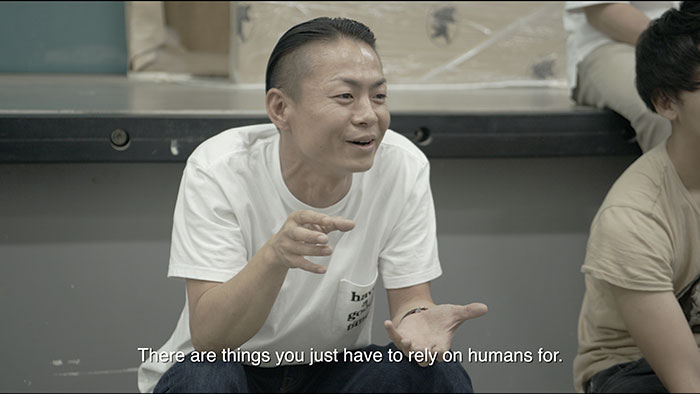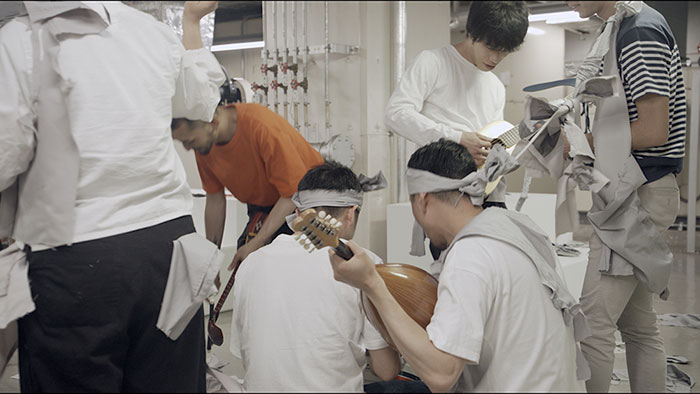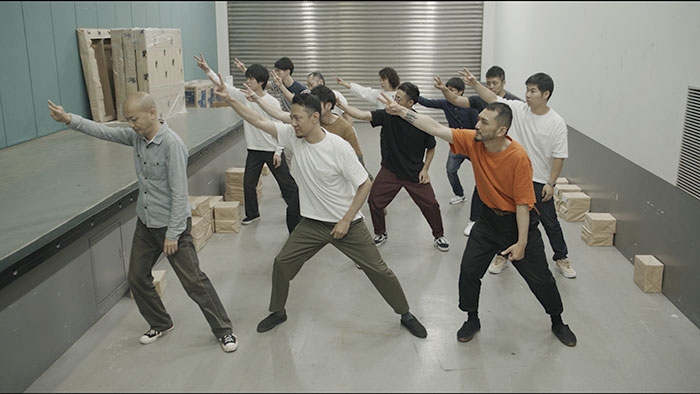Unboxing the Future is on show at Galerie Tanja Wagner, Berlin, until 22 April. As part of an initiative to encourage self-isolation during the COVID-19 pandemic the gallery has made the central film available online.
Three men stand before a neutral background, their empty hands enacting machinic processes of grabbing, moving, positioning, assembling, folding, counting, processing, unpacking or packing. At least those are some of the possible ways of interpreting whatever it is they are doing. The soundtrack is a series of chords struck on a stringed instrument, possibly a koto. It’s not quite clear if this is some form of contemporary dance, calisthenics, meditation, or the effects of muscle memory and automatic behaviour. But it has a green-screen characteristic, in the sense that this appears to be a performance that will have context added to the content at some later stage. One of the actors has ‘have a good time’ printed on his T-shirt pocket. It’s equally unclear as to whether or not this is sincere, ironic, or simply a matter of chance, but it’s the only direct message in view.
The scene marks the opening of a three-channel videowork by Vienna-based German artist Anna Witt, titled Unboxing the Future. It is, in some ways, a follow-up to an earlier videowork, CARE (2017), which focused on two Indonesian geriatric nurses caring for dementia patients in Japan and a more general body of work addressing labour, precarity and societal formation. Unboxing the Future was commissioned for last year’s ill-fated edition of the Aichi Triennale (which was overtaken by controversies surrounding censorship following the closure of a section titled ‘After Freedom of Expression?’) and is now on show at Galerie Tanja Wagner in Berlin. The actors in this undrama are workers in the Toyota factory in Toyota city (formerly Koromo but renamed in 1959 because of its status as the headquarters and main production hub of the car manufacturer) in Aichi Prefecture. Next to the factory is the Toyota Kaikan Museum, where new cars and occasionally new robots are displayed to the public. Toyota, then, means many things. It is an industry, an economy, a performance, a city, a lifestyle and a culture. And, of course, somewhere in the midst of all that, a brand of automobile.
The museum is also the meeting point for daily public tours of the Toyota production plant in which the artwork is shot. Witt recalls being particularly struck by the production process on her first visit: “On the one hand, it’s done by robots, and more particularly robot arms; on the other hand, you have these line workers who are incredibly skilled, super fast, and the way they move is like a performance.” There’s a sense then in which her performers are an objet trouvé.
What in other places is often described as a job killer, is here, in the face of Japan’s aging and declining population, an industry saviour
Cut to a conversation among a larger group of workers (subtitled in English) and a move from objets to subjects. One describes how automation has reduced what was once a four-person job on the line to a solo occupation. AI is becoming an increasingly normal part of Japan’s manufacturing industry. What in other places is often described as a job killer (or in extreme cases, featuring rogue robots and military drones, just a killer), is here, in the face of Japan’s aging and declining population (predicted to drop from around 127 million people to under 100 million by 2049), an industry saviour. The workers recognise this. But this new kind of work is uninteresting, the workers struggle to find motivation or job satisfaction. Now work is too easy. At this point, for the viewer, a question arises concerning what the function of labour might be today. Is it still to produce ‘stuff’? Is it to produce value? How is that value measured from the worker’s point of view? Does it derive from overcoming challenges faced? Is it a question of satisfaction? Is it entertainment value? Moreover, if work is starting to seem like a form of leisure (albeit of the boring rather than the fun variety), where does that leave leisure? The workers will reach that line of questioning later on. For now, they are worrying about the notion that they might, at some fast-approaching point in the future, become redundant. Or as they slip into a more human register, and work begins to become a matter of relationships, that they might not be needed, that they might be rejected. One of the participants describes a section of the production line in which one worker operates a machine while three others inspect what it produces. He worries that if, as seems possible, an AI takes over the inspection functions, then the machine worker will be left alone. It’s loneliness that is the problem. That worker is now on the centre screen, miming the production actions. The screens to his sides show an empty space and a lonely pile of boxes.
‘It can be hard to notice the signs that you are stagnating in your job,’ ‘workplace thought-leader’ Liz Ryan noted in a slightly OTT selfhelp article in Forbes back in 2016. ‘If you’re not learning new things all the time, you are slipping backwards, because time doesn’t stop. The only thing you will ever have to sell to a new employer or to your clients is your background – the experiences you’ve had, the judgment you’ve acquired and the stories you are in a position to tell. None of these things will grow unless you are growing in your job all the time!’ So perhaps labour today is a question of accumulated experiences and stories, like the ones being shared in this video. Unless that’s a roundabout way of saying that labour is one of the ways by which people accrue identity. A personality. Indeed, later on in the video, one of the workers will say that he is his job (until relatively recently people working for larger employers in Japan expected and were expected to stay loyal for life).
The discussion moves on to describe how AI is in fact relatively inefficient at assessing quality. “There are things that robots cannot see,” one worker exclaims, pointing out that the human eye is an amazing construction. “That is our strength!” another says. But cameras are catching up. “The future is almost here,” a colleague warns as two of the channels cut to workers going through the motions of an inspection, looking and pointing around while only their upper bodies move. As though they are reduced to torsos, heads and arms – their bodies slowly being erased.



A robotic arm replaces one of the workers on screen, then another, until the worker in the centre increasingly looks like he is mimicking the machines rather than any human action, and workers begin to speculate about what a society without labour might be like. A society in which “we just do what we want to do”. “We chose our jobs to follow our dreams,” one of them asserts.
And what of free will? (The word ‘robot’ derives from the Czech robota, meaning forced labour, and evolved from the feudal class system – although questions of class don’t seem to be much of an issue for these workers. While Witt points out that while the group in the video was assembled to act as a type of ‘workers’ forum’, it is in fact comprised of both labourers and engineers, classes of worker that would not normally interact.) On the centre screen, a group of workers are performing in sync as a group. Maybe AI will lead to a new way of thinking, because it will take care of discussions about efficiency and progress to the point that humans won’t have to think about that anymore. The group, arranged in a grid, perform their actions (which now seem totally robotic) again. Some of the performers talk to each other. It’s the first time this has happened outside of the forum moments.
Back to the discussion, where one of the workers reflects on the fact that if he works an eight-hour day and sleeps for another eight, and lives until ninety, he’ll only have 30 years of excess time to work out what to do with, to have a ‘private life’. If you factor in overtime, that might be only 10 or 20 years. But in a world without labour that might stretch to 60 years. How would he know what to do with that? Right now, leisure is a reward, it might lose its value if things change. Moreover, the group discuss, if you have to think about leisure it might become more like work. Even for those who don’t like their jobs. We’re reaching the horizon of an ambition. And the ambition is to have fun.
One worker reflects on the fact that if he works an eight-hour day and sleeps for another eight, and lives until ninety, he’ll only have 30 years left over
In 1938, the Dutch historian Johan Huizinga published Homo Ludens, a study of the essential importance of play to the development of culture and society. The book went on to influence the thinking of the Situationist International through the 1950s and 60s and, in recent years, game theory. In it, Huizinga offers five characteristics that define play. The first is that is an exercise of freedom and free will; the second two determine that it is distinct from ‘ordinary’ or ‘real’ life; the fourth is that it requires order; and the fifth that it is without interest – that no profit can be gained from it. Above all, he asserted, it is about having fun. During their discussions about their anxieties the workers cover issues that comprise the first four. And they are about to come on to the fifth. But for the moment, the nervous, utopian discussion in Toyota City brings to mind New Babylon, the anticapitalist city of play (inspired by Huizinga’s study) imagined by the artist and sometime-Situationist Constant Nieuwenhuys in a series of sculptures, drawings, paintings and films made between 1959 and 1974. Constant imagined a world in which automation had made work, rather than workers, redundant. His speculative cityscape was therefore designed to cater to and embody a society of leisure, a society based on play. ‘It is obvious that a person free to use his time for the whole of his life, free to go where he wants, when he wants, cannot make the greatest use of his freedom in a world ruled by the clock and the imperative of a fixed abode,’ the Dutchman wrote. ‘As a way of life homo ludens will demand, firstly, that he responds to his need for play, for adventure, for mobility, as well as all the conditions that facilitate the free creation of his own life… Homo ludens himself will seek to transform, to recreate, [his] surroundings, that world, according to his new needs.’ Which of course is a rather self-serving way of saying that homo ludens will turn to art. But what’s most striking, watching Witt’s videowork, is the way in which what for Constant’s generation was a utopian scenario – a model of living the dream – is, for the Toyota workers a cause of anxiety and fear, if not quite a nightmare.
The workers are now performing synchronised actions in a circle. The group discuss how work improves them as individuals and as a social group. Meanwhile other people are putting utopian dreams in place on their behalf. There’s a revolution going on around them.
This January, at the annual Consumer Electronics Show in Las Vegas, Toyota announced the construction of Woven City, a city of the future, designed in collaboration with the Danish architect Bjarke Ingels’s firm BIG (a firm that presents its projects as artworks) on a 175-acre site that was formerly home to one of its factories. It will use it to test AI, driverless cars and advanced robots. And the ways in which these interact with humans – the 2,000 of them (employees, researchers and their families) that will live there. ‘In an age when technology, social media and online retail is replacing and eliminating our natural meeting places, the Woven City will explore ways to stimulate human interaction in the urban space,’ Ingels told CNN at the launch. ‘After all, human connectivity is the kind of connectivity that triggers wellbeing and happiness, productivity and innovation.’ Woven City ties into a larger plan adopted by the Japanese government in 2015 titled ‘Society 5.0’. It aims at creating ‘a human-centered society that balances economic advancement with the resolution of social problems by a system that highly integrates cyberspace and physical space’. It’s an ‘improvement’ on Society 4.0 (the ‘information society’) ‘because there is a limit to what people can do’.
Witt’s workers worry about how they will earn money to fund all this leisure time. They have a point: in worker communities around the world, leisure means shopping malls, and shopping malls require money. “I like music,” says one. “Maybe I’ll start learning the guitar.” The workers perform a discordant instrumental on a variety of stringed instruments, among them guitars, lutes and shamisen. Drums and cymbals join in. The workers begin cutting up each other’s grey-white overalls. Removing cuffs and sections. Creating everything from rags to what might pass as contemporary designerwear. A kind of play, that also looks a bit dangerous as the scissors cut so close to the bodies.
One of the workers recalls a time when he tried to grow rice using only manual labour. It was hard. Machines are good, he concludes. They have liberated us. The problem, another concludes, remains money. Society is too based on an economy where everything has a price. The Japanese are too serious, a female worker suggests. Too much governed by rules. She feels trapped in a box. A times she feels compelled to raise her arms while queueing for the subway. She apologises to her colleagues for her outrageous assertions. They voice a form of muted support.
Cut to machine dials. The group perform the music and the dance they’ve been rehearsing all along. “I proposed some performance elements,” Witt confesses, “but a huge part of the work is the initiative of the workers: they performed the music and created the choreography. It is very much their own input.” Press play.
